Presenting the historical formal wear and fancy dress collection.
In honour of the 100th anniversary of the museum, Huis Van Gijn presents a special selection out of its fashion collection. Discover the anniversary presentation of party and costume clothing in the unique setting of the historic interiors! In this brochure you will find the story behind the 25 costumes you will find in six different rooms of the house.
In the 19th century, fancy dress parties were extremely popular in all levels of society, all year round. Associations like skating clubs and dancing schools organize costume parties for the wider population. Well-to-do citizens amuse themselves at masquerade balls and costumed parties at exclusive ‘socials’ or at each other's homes.
GARDEN ROOM – GROUND FLOOR
TABLEAU VIVANT
‘Living pictures’ (tableaux vivants) and short plays are popular forms of entertainment at private parties. Guests act out important events from national or family history, as well as Biblical and mythological stories.
Putting on a tableau or play takes a lot of work. Entire rooms are converted into stages, with screens, curtains, furniture, costumes and props. Participants in the tableaux vivants choose their poses carefully and they even take care to properly light the room.
Do you see …
...the three gowns?
The brown gown is part of a living picture by the family of the Cornelia Vriesendorp, wife of Simon van Gijn. You can find the gown in the picture to the right, on the far right. The other two gowns were reworked for costume parties. The silver-blue damask (patterned woven silk) gown is already over a century old when it is made up in 1890.
- Gown brown with sheep's leg sleeves, silk, 1830-1840.
- Afternoon gown light brown, silk, 1840-1845 fashioned from older gown, 1830-1835.
- Dressing gown à l'anglaise silver blue from 1766, silk damask, reworked for ‘dressing up’ in c. 1890. Worn by Winanda Staring with Piet Blussé at the golden wedding of couple Blussé-Soek,1890. And at a costume party in 1928 by Coralie Vriesendorp.
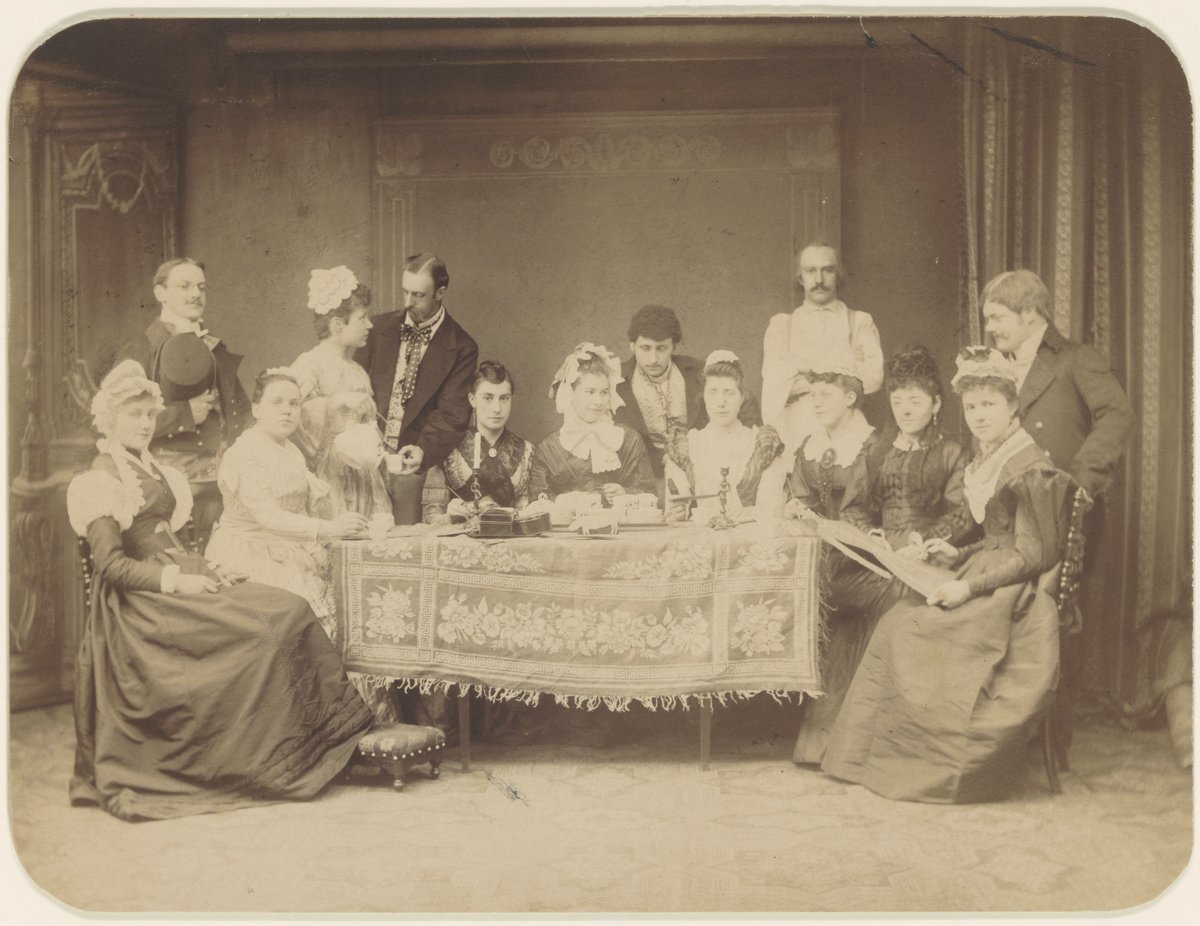
Performance of ‘the Gilding Party', held on the occasion of the marriage of M.A. Vriesendorp and H. Roodenburg.
1889
DINING ROOM – GROUND FLOOR
WEDDING
The wedding dress is the festive attire we are most familiar with. However, the white dress as we know it today is relatively modern. Getting married in white became more common among wealthy families around 1860. Brides from less affluent families preferred a new, neat gown in a colour they could continue to wear after their wedding day.
Do you see …
... the three wedding dresses?
They are not all white. One is pink and one is, surprisingly, black. The black colour would have been chosen because the prospective bride and groom are over 30. But it could also be because of a mourning period. The bride's father died nine months before the wedding.
... the wedding service on the table? And all the objects in the cupboard: a menu card, a wedding song, wedding tokens and engraved glasses. Plates of a wedding service by Boch Luxembourg from 1794, with portraits of the couple, painted by a unknown painter. They are tangible memories of the wedding day, for the couple and future generations.
- Salmon pink wedding gown worn by Willemina Frederika de Geus-de Leeuw, silk, crepe, lace, 1928.
- White wedding gown worn by Johanna Houkjen Staring-Blussé, silk and cotton, 1875.
- Wedding suit worn by Jetse Auke Bouma (tailor), cloth (wool) and cotton, 1902.
- Wedding gown black worn by Pieternella Jacoba Reus-Ouburgh, cotton and silk, 1905.
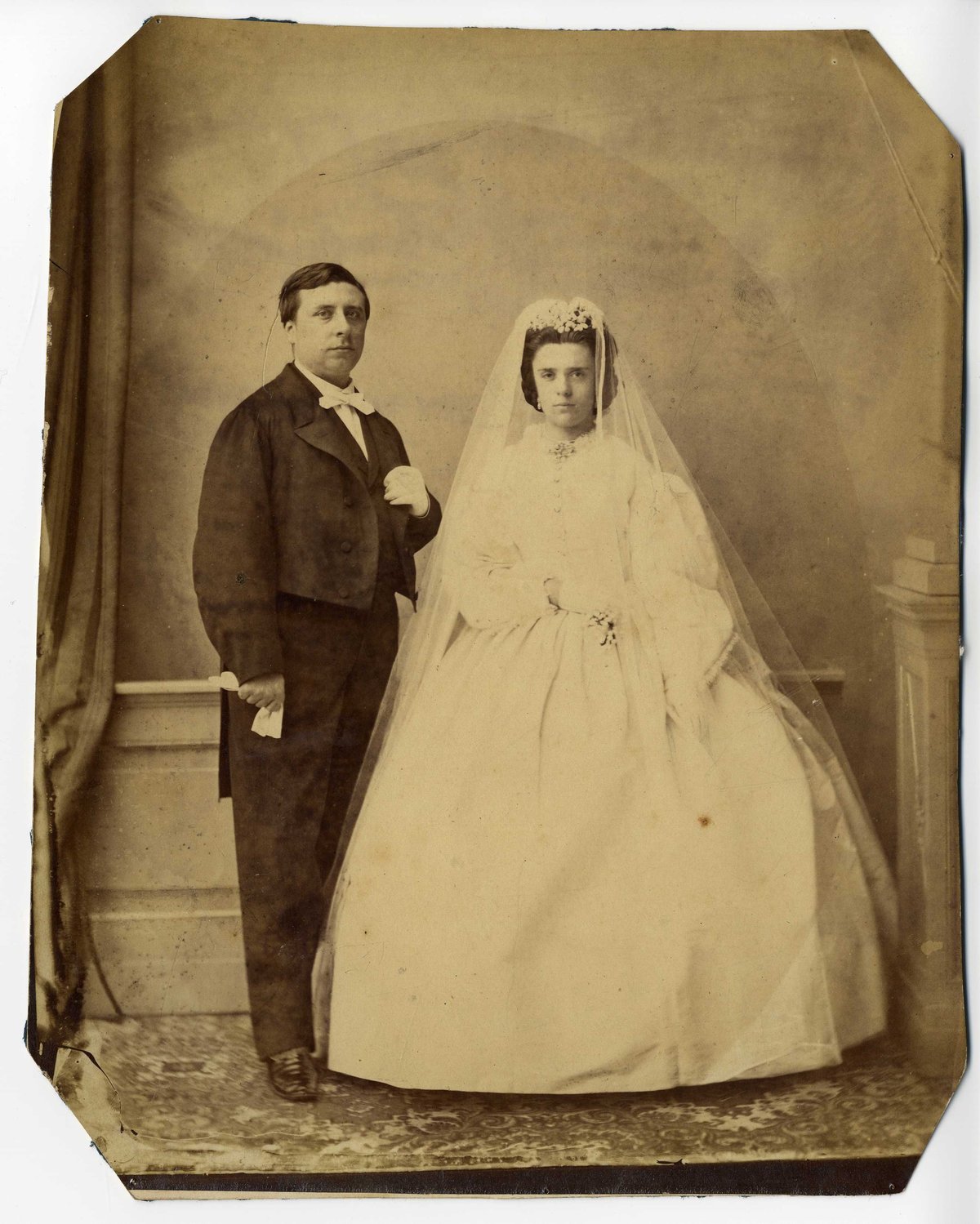
The lady of the house, Cornelia, chooses a white wedding dress for her wedding to Simon van Gijn.
1864
RED SALON – GROUND FLOOR
SOIREE
Going to the theatre, dining or dancing? Special occasions require special clothing. The etiquette books will tell you very specifically what you should wear and when.
Do you see …
... invitations on the cabinet on the left? The timing of the invitation determines how you should be dressed. The longer in advance you are invited, the more elaborate your clothes should be. The evening dress with train, bare shoulders and matching cape is something your could wear when you are invited a week in advance.
.... the black shimmering flapper dress? The 1920s see the emergence of a vibrant nightlife scene. During the roaring twenties, fashions become looser and shorter.
... the ‘liberation skirt’? After the liberation Mies Boissevain Van Lennep calls on all women in the Netherlands to make a skirt from rags and fabric scraps from the war - a symbol of solidarity, rebuilding and renewal.
- Evening dress “flapperdress”, silk, worn by Neeltje van Aardenne, c. 1925.
- Evening gown with shoulder cape, silk with interwoven silver thread, worn by Elise Margaretha Staring-Valke ca. 1935-1940.
- Liberation skirt with beret, made and worn by Margaretha Gerarda Daamen, cotton, 1948.
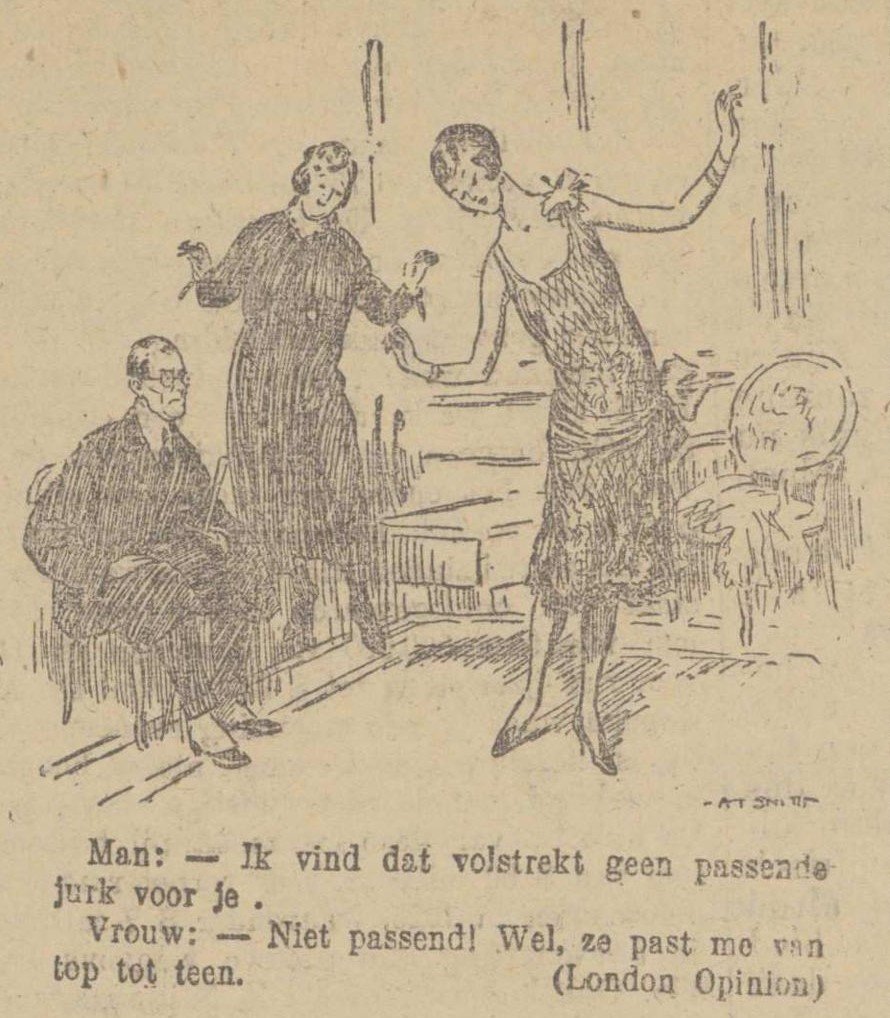
“ Man: Ik don’t think this is a fitting dress for you to wear. Woman: Not fitting! It fits met perfectly.”
HALL – GROUND FLOOR
COSTUME PARTY
Costume parties are very popular among the elite. Partygoers are only too happy to dress up, preferably in period clothing. In the attic of upper-class houses you would often find chests filled with ancestors' clothes. The clothes are often adapted and embellished for these occasion. But special dress-up clothes are also made – either by the wearers themselves or by seamstresses.
Do you see …
... the sailor outfit within this parade of children's costumes? The well-known writer Top Naeff is four when she wears this costume for a performance. Remarkably, a photo of it has been preserved.
… the pink dress is part of a tableau vivant that was arranged for the occasion of 12.5-year wedding anniversary of the Dordrecht couple Van Twist-Veth. The dress can change skirts and is worn by their 11-year-old daughter Helena.
Donation private collection, 2023:
- Costume dress, “student”, 1920s.
- Costume dress, Alsatian costume, c. 1920s.
- Costume dress, peasant woman, 1898.
- ‘Pierrette’ dress, c. 1920s.
- Costume dress, flower, c. 1920s.
Loan private collection, 2019:
- Costume Arab sheikh, 1915-1930.
- Matador costume with hat, 1915-1930.
- Pierrot costume, 1915-1930.
Donation fam ZurMuhlen-van Spengler, 2017:
- Freebooter (buccaneer/adventurer) or knight costume, 1905-1910.
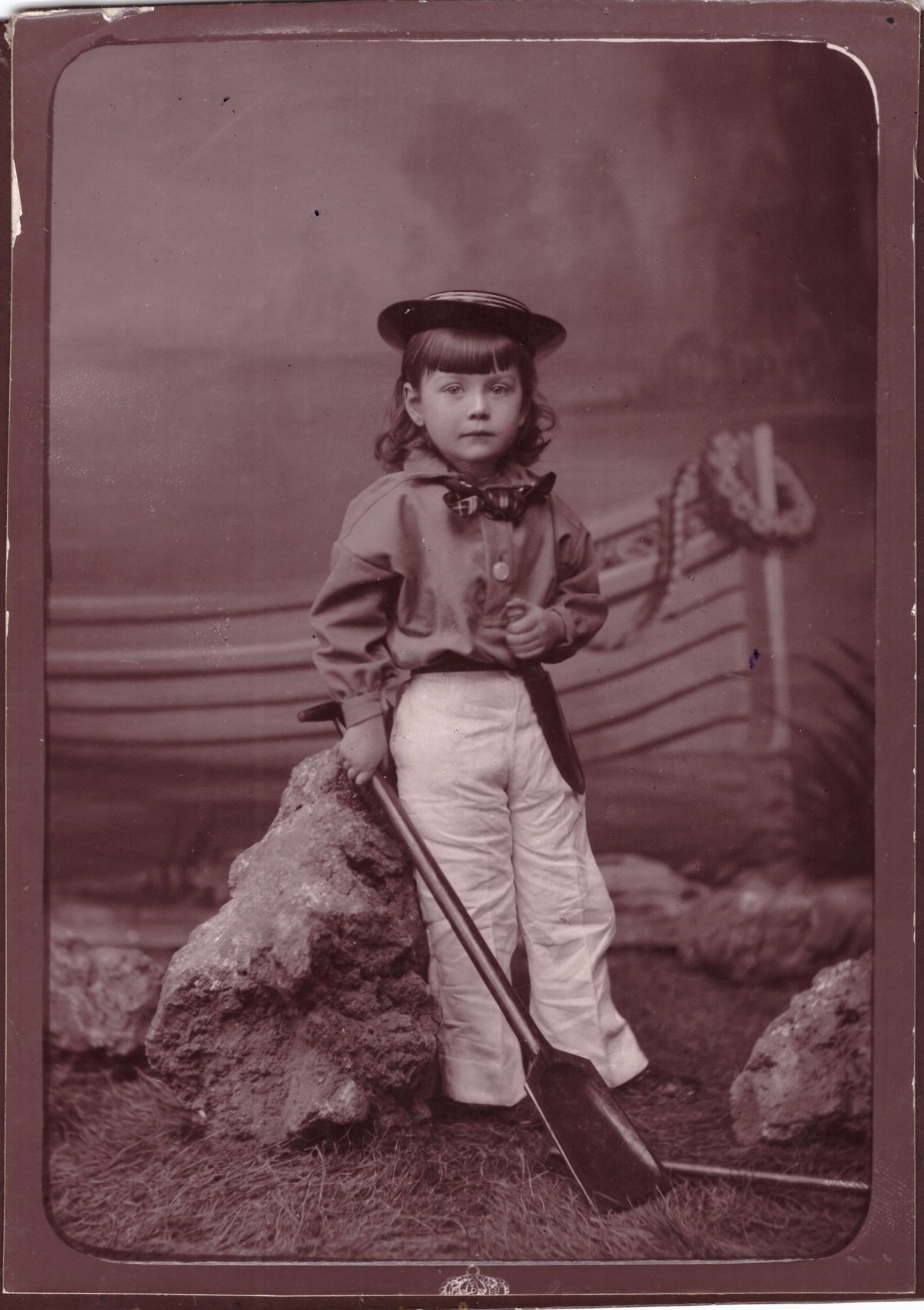
Top Naeff in her sailor costume and ‘ponjaard’ (dagger).
c. 1882
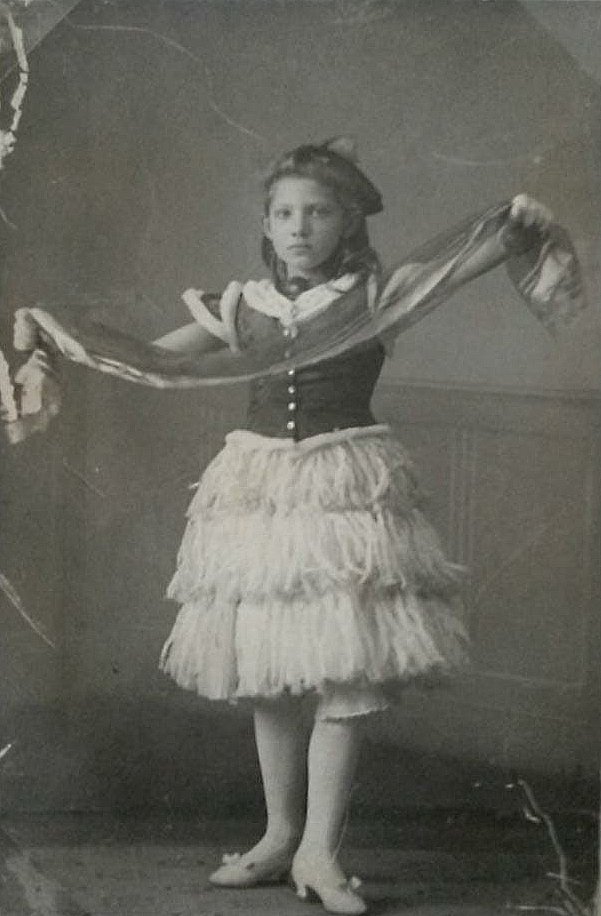
Helena Francina Alida van Twist in her costume dress.
c. 1910
LIBRARY – FIRST FLOOR
MASQUERADE
In the 19th century, costumed student parades, masquerades, were popular. Onlookers marvel at the spectacular parades. Lustra of universities and societies are often celebrated with an “arrival” of a historical figure from patriotic history by parade.
Do you see …
... the masquerade costume? Simon van Gijn studies law in Leiden and is elected to the masquerade committee of the Leids Studenten Corps. During this year Simon has a day job organising the masquerade; the arrival (parade) of the Duke of Anjou in Antwerp in 1582. He also designs the costumes - reconstructions of the historical clothes . Design drawings by his hand have survived.
In the bookcase: Masquerade of 1860, from left to right:
- Historical description of the masquerade, 1860.
- Programme booklet of the masquerade, 1860.
- Masquerade album with a fold-out lithograph of the parade, by G.J. Bos, 1860.
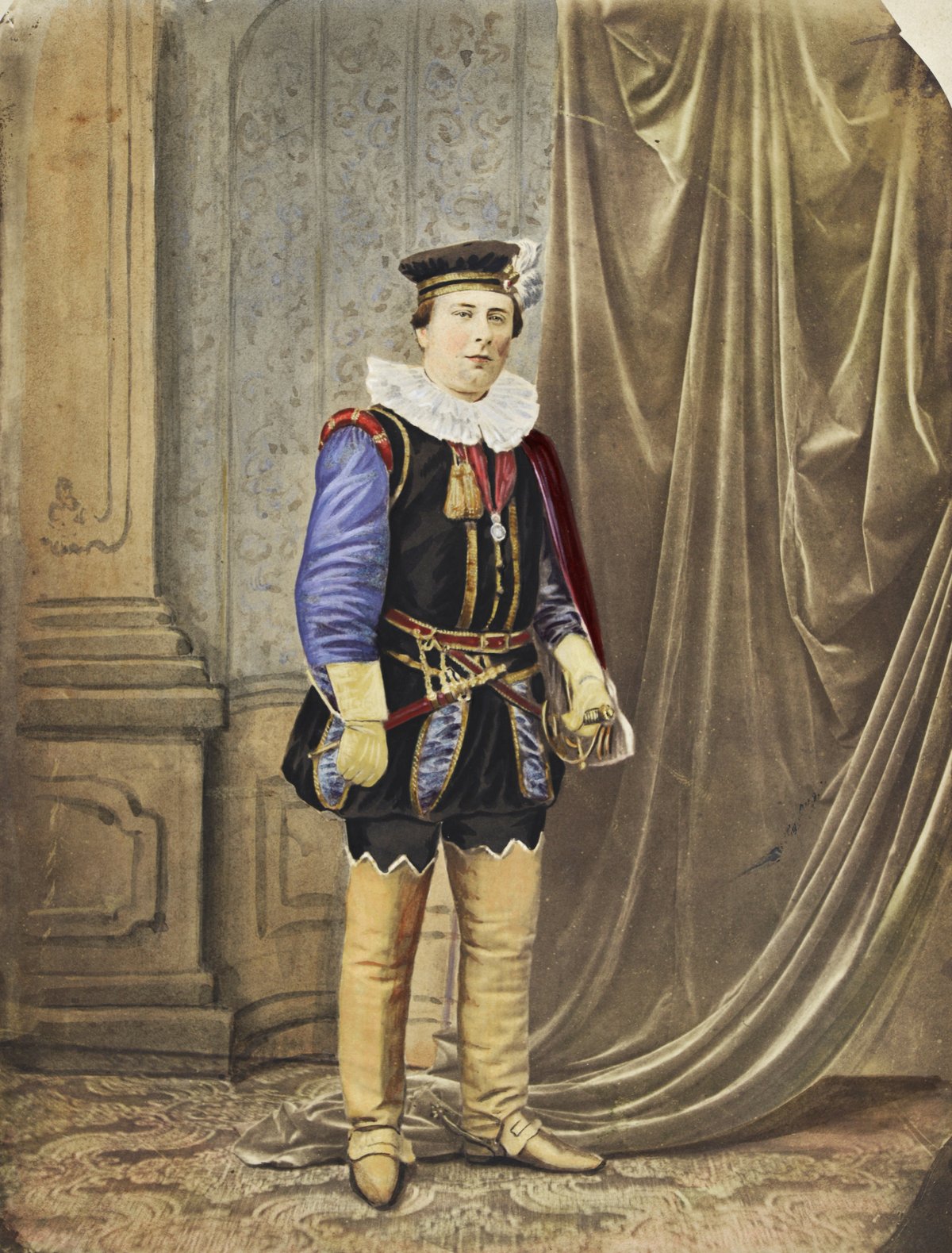
Simon van Gijn in his masquerade costume, coloured photograph.
1860
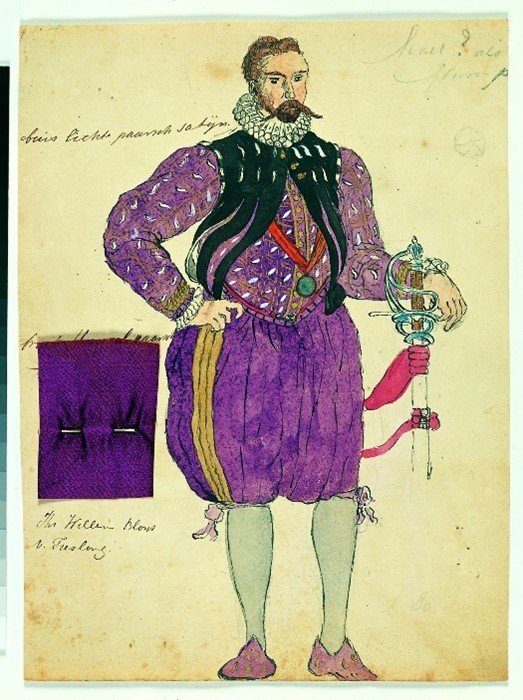
Costume design by Simon van Gijn, coloured drawing.
1860
OFFICE – FIRST FLOOR
A ROYAL VISIT
A visit from an emperor, king or queen calls for special attire. Senior officials, such as members of parliament and ministers, wear ceremonial uniforms at the receptions in the 19th century. The costume consists of a dress coat (with tails) and trousers, decorative dung (sword) and a stitch (headwear) with ostrich feathers.
Do you see …
... the white costume? This honorary guard costume is made for a visit of Napoleon to Dordrecht in 1811. Being part of the garde d'honneur is a huge honour, but you have to pay for the new costume yourself.
... the skirt coat with the gold embroidery? This is the ceremonial outfit of a member of the House of Representatives between 1850 and 1875. Such a uniform was expensive and was often passed down to relatives in a similar position.
The honour guard uniform with the Dordrecht city arms embroidered in red was specially made in 1897 for a visit by Queen Wilhelmina and Queen Regent Emma to Dordrecht.
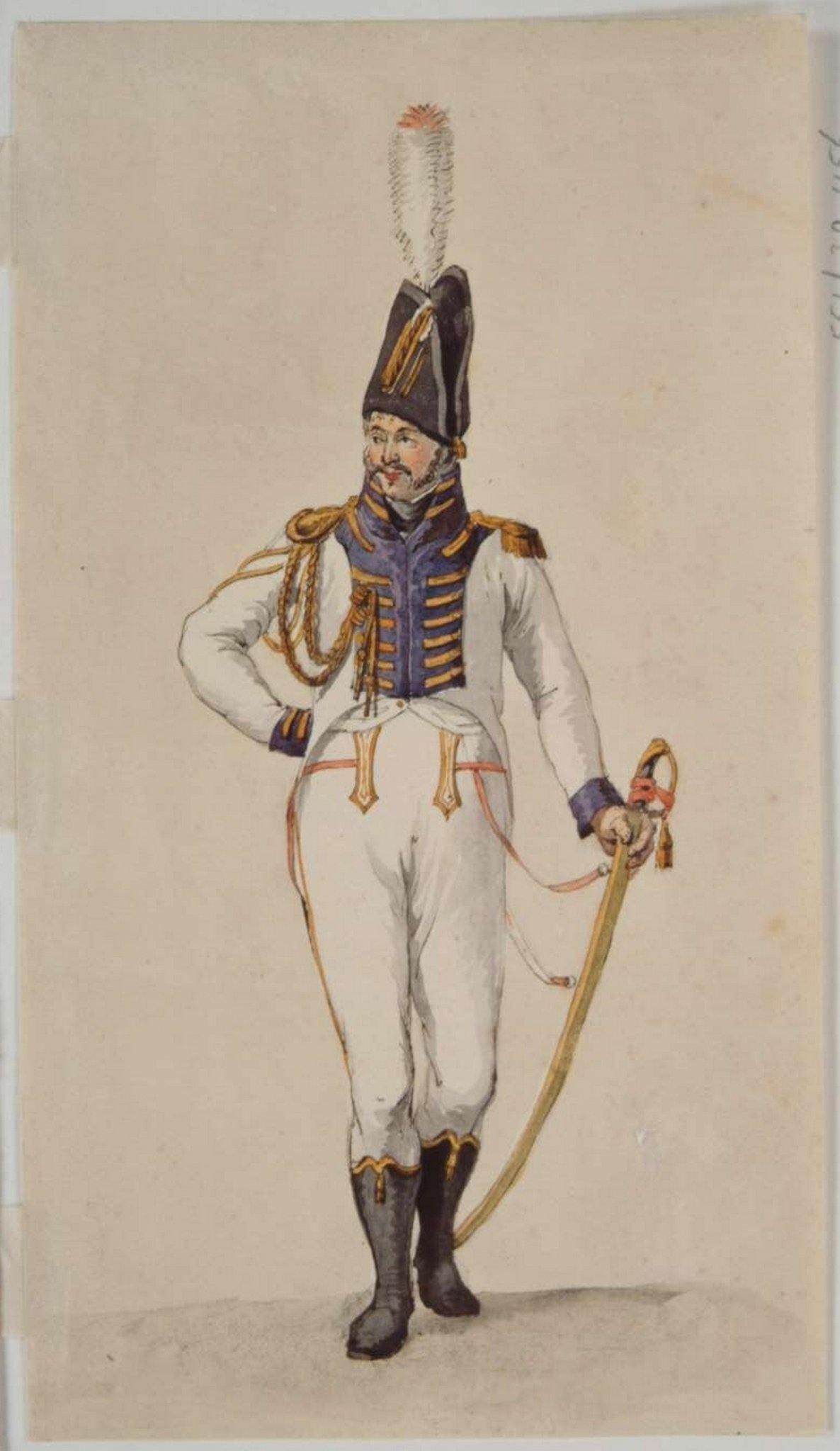
This honorary guard costume is made for a visit of Napoleon to Dordrecht.
1811
